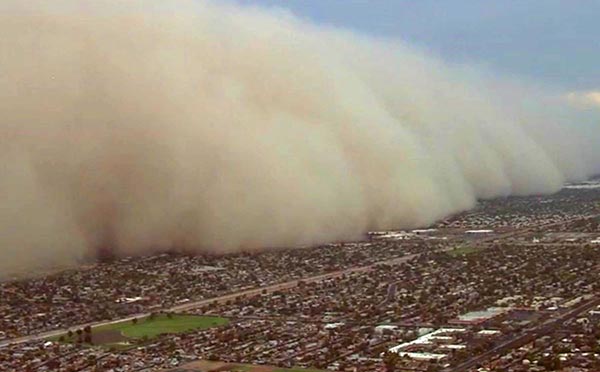 |
  
|
The Santa Barbara Simoom of 1859Stories of a lethally hot storm wind in Santa Barbara in 1859 persist to this day. Skeptoid Podcast #424  by Brian Dunning Today we're going to go back more than a century and a half to a hot summer day on the central coast of California, to the town of Santa Barbara. June 17, 1859 began as a summer day much like any other, clear with plenty of warm sunshine, plus a cool breeze to make it just perfect. But according to legend, something happened that wrought sudden death and destruction: from out of nowhere, a wind with temperatures usually reserved for baking ovens blasted down from the hills, killing animals and injuring people. It immediately set the country's highest recorded temperature. They named it the simoom, after the hot Sahara wind of the same name. But it turns out that data is hard to come by. Was the Santa Barbara simoom a true freak of nature, or perhaps merely a tall tale told to visitors? Here is a snippet about the 1859 simoom from the Insider's Guide to Santa Barbara:
It sounds a bit like a tall tale, a perfect subject for our skeptical eye. Sudden, hot winds are absolutely a reality on the California coasts. They're called the Santa Ana winds, and are the main contributors to the wildfires that can so often be so destructive to coastal communities. Dry air from the Mojave Desert and even the Great Basin further inland forms a high pressure region which cools, sending it spilling downhill toward the coast. The wind is very dry and gusts can reach hurricane forces at their strongest. The wind is usually hot, but not because it came from the desert; it gets heated on the way by adiabatic forces; basically, compression. Santa Ana winds can happen at any time of year, but are most common in the late autumn and early winter. Although Santa Barbara is a ways up the coast from the Santa Ana winds, it is indirectly affected by them. The high pressure systems that create the Santa Anas are usually moving east, so a few days before they collapse into Santa Anas, they often cause a similar phenomenon in Santa Barbara that locals call the Sundowner. When the Sundowner winds spill over the Santa Ynez mountains and rush to the sea, they can wreak some havoc; but because their path is much shorter, adiabatic compression forces don't have as much opportunity to heat the Sundowners as much as their more southerly cousins. As for the term simoom, it's the Arabic word for a sudden, hot wind filled with sand. Searching old newspapers from the 19th century in the United States, I discovered (somewhat to my surprise) that the word simoom was often used in the press in reference to gusty winds. So it is not surprising that the original recounters of this particular story called it a simoom. Most of the sources for this tale cite a 1966 book Goleta, the Good Land where author Walker Tompkins told it with a fair bit of dramatic bravado, but his only known source was a much older book — 100 years older. It was a coastal survey published in 1869, ten years after the alleged event, by the United States Coast Survey, called Coast Pilot: California, Oregon, and Washington Territory. Author George Davidson was an assistant surveyor on that trip, and later became the University of California's first professor of geography. Here is the entirety of Davidson's account, and so far as anyone knows, this does indeed represent the earliest and most complete account of the incident:
Tompkin's 1966 account added minor details, like people taking refuge behind walls and buildings, and animals jumping into wells for refuge and drowning, to the point that clearing out the wells afterward was problematic. But since Tompkins gave no other source and the accounts were similar on the major points, it's probable that his minor additions were attributable only to dramatic license. Tompkins did make the assumption that Davidson's survey recorded the 133° from their boat at sea, a note that is probably wrong. Davidson related the story of the simoom as the only recorded such case in California, but made no suggestion that either he or other members of his survey were present when it happened. Indeed, Davidson went on to say, in his next paragraph, that he and his party frequently experienced similar (but much cooler) blasts of winds while making astronomical observations ashore in 1850. So in all likelihood, Davidson was relating a local story, not giving a personal account. In 2010, Bill Norrington at the University of California, Santa Barbara Department of Geography asked Professor Joel Michaelsen what he thought about Tompkin's version of the story. He answered:
As stated earlier, modern retellings often claim that this 133°F was considered an official record. Not so; the historical high for Santa Barbara on June 17 is 36°C/96°F, which was recorded in 1957, a record that stands today. The simoom's 133°F does not, in fact, have any authority as an actual measurement. Nor should it, according to meteorologist Christopher C. Burt writing for Weather Underground. In 2010 he compiled a list of various claims for the highest recorded temperature ever on Earth, and assigned each one a validity score of 0 to 10. He gave the 1859 simoom story a 1 out of 10, saying:
...the most important point being that there's no record of that 133°F measurement ever actually having been made... just like the other claims on Burt's list. They include the 58°C/136°F said to have been measured in Libya in 1922, to which he also gave a 1 out of 10, citing overwhelming evidence against its reliability. The current official record holder, 57°C/134°F at Death Valley, California in 1913, gets a 5 out of 10 from Burt; evidence shows that it was probably an error, but there is no way to know. Burt's only 10 out of 10, a truly proven measurement, was 54°C/129°F also at Death Valley on multiple occasions, and probably should be the official highest temperature. Update: Since broken! 54.4°C/130.0°F was reached at Death Valley on July 9, 2021. —BD One of the things that struck me about the details was the fisherman with his blistered arms. Being in very dry air at 56°C/133°F (humidity is as low as 10% in Sundowner winds) does not blister skin; however, sunburn from being in an open boat for half a day or more can very easily blister your skin, regardless of the temperature. Cattle and rabbits survive temperatures in the 50+°C/120+°F range all the time, birds don't suddenly die and fall out of the air; the only plausible things in the account is that thick adobe walls do indeed provide a nice cool environment on hot days, and that fruit that falls from a tree and lands on a frying hot surface will indeed appear to be scorched on one side only. No shocking, extraordinary stories necessary. Most likely what happened was an extraordinarily hot and powerful Sundowner wind, perhaps one strong enough that people talked about it for a few years. We know for a fact that they do happen, and we know for a fact that they are sometimes unusually hot and strong. The hottest Sundowner ever was 43°C/109°F in 1990, and Sundowners frequently reach hurricane force. We have every reason to conclude that whatever event prompted the tall tale of the 1859 simoom was probably in this range. Over the past century and a half, no researcher has ever uncovered evidence of the event that anyone thought it was exceptional enough to publish until the coast survey 10 years later. We have meteorological precedent and a suspicious lack of documentary evidence to support a strong Sundowner as the probable explanation for the stunning 1859 simoom. Update: A couple of secondary sources have popped up from 1859, but still no primary sources. See this listener feedback episode for the details. —BD
Cite this article:
©2025 Skeptoid Media, Inc. All Rights Reserved. |